Finnish
N/A
Fri, 11th April, 2025 - 11:02 pm GMT
Sponsor Ads:

Alternative Name
N/ABasic Info
Today there are four types of Finnhorse: a lightly built (J), a heavy breed (T), a versatile riding horse (R), and a smaller pony type horse (P). Finnhorses are approximately 14.2 to 15.3 hands high at the withers. They are strongly built with good limbs. Horse of the draught type are heavier and longer than horse of the trotter and riding horse types. Most Finnhorses are chestnuts, often with flaxen tail and mane. Bay, greay and more rarely brown or black are also seen.
Health
N/AHabitat
N/ABehavior
Finnish horses are willing, forward-going, hardy and tough horses.Origin
FinlandHistory
Finnish horse is the only native breed of horse in Finland. It is a descendant of the northern European domestic horse with both warmblood and heavier draft influences. This breed is also known as Finnish Universal because it is able to fulfill all the needs for horses in Finland. It is the fastest cold-blooded trotter in the world, it is capable of pulling heavier loads than many larger draft horse breeds, and it is a versatile riding horse. In 1924 it was ordered that breeding of the Finnhorse be divided into two branches. Breeding of the heavy type for agricultural and forestry work continued with increased attention to developing a lighter type suitable for riding and racing. Today, the heavy Finnhorse is still used for forestry work, as a horse is less damaging to a young forest than heavy equipment. However, they are not used as frequently in agriculture since mechanization. Trotting is very popular in Finland and about 40 percent of the horses racing there are Finnhorses. Regrettably, these horses have declined in numbers since the 1950s, and presently their number is about 19,000. The majority of these Finnhorses are trotters. In the 1970s, there was a revival of interest in horse sports in Finland and in 1971 the riding type of the Finnhorse was given a separate branch of the studbook. Today, Finnhorses participate in dressage, show jumping, eventing and long-distance riding competitions, as well as driving classes and trotting races. In addition, the Finnish horses are popular family horses and riding school mounts.Common Foods
grassSponsor Ads:
"For Brutus is an honourable man; So are they all, all honourable men". -- Julius Caesar Act III, Sc. II, William Shakespeare
Finnish
Coded by: BGID® | ALL RIGHTS RESERVED Copyright © 2000-2025
Disclaimer | Privacy | Report Errors / Contact | Credits
















